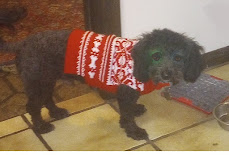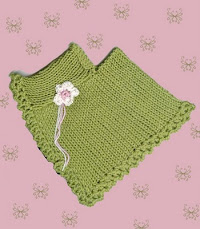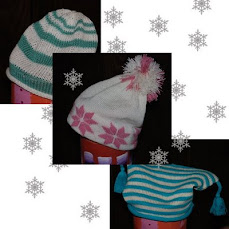This is for a standard gauge machine, only one size (sorry), T 6 with 7st and 10 rows to the inch. Before I started the pattern, did a hem for the body pieces. I cast on with waste yarn the specified number of stitches, knit 12 rows T 5, one turning row of T 7, 12 rows T 6. Hung a hem and knit one row at T 8. Back to T 6 and RC 000. Knit as instructed to the top and took the final st off on waste yarn. For the sleeves, I did a hem with the same tensions but only 8 rows. For the front bands I picked up one whole st with the back side facing me and did the same kind of hem with just 6 rows. Same as the front plackets for neckline at the very end after pieces were seamed. I did full fashioned decreases on all pieces to make seaming easier. Still debating whether to have a button closure at the top. The sleeves are long enough to fold over as a cuff and lower as the arms grow. PS-- DAK (where I created the pattern) names things from the perspective of the wearer, but as you sew the pieces together you'll see how the tops of the sleeves slant to create a nice neckline. By changing the tensions for the hems, I didn't have any problems with curling. Don't like to steam acrylics too much.
The yarn I used was Trenzado, I think. It was a mystery yarn given out for free at a guild meeting. If you'd like to try this pattern, you could use any yarn that knits close to the gauge.
The hats I did are super simple. Ewrapped on 110 stitches T 4 knit 8 rows. Increased one stitch both sides. RC 000, T 6 knit 78 rows. Tried something different for the tops which saved some time. I tranferred two stitches over two needles. (2 in work, 2 out of work) to decrease. Then knit 2 rows still T6 and took off on a threaded double eyed needle to cinch in and sew up the seam. Makes a nice top! Then I knit a 4 needle I cord for 160 rows, T4, to make a bow for the top. Hid the ends of the I cord up into the I cord. Tied the I cord into a bow, tacked it down well and hid the sewing ends on the inside.
Our guild has a challenge to its members to knit as many charity items as is our age. Have done this before and it IS quite a challenge. (I'm 39, after all.) I think I'm about half ways there. Have about 8 months to go.










































































13 comments:
Hi Mar, that is so cute!! I make a hat similar to that, but I make eyelets for the I cord to thread through. I'm not sure if I have a picture of it still. If do I will post it on my blog. ;-) Dhrtyl
reanHi Mar, that is do cute!! I make a hat similar to that but I make eyelets for the I cord to thread through. ;-) Sheryl
How nice. And good idea to post the DAK charts.
Thanks, Sandy and Sheryl. Seems easy to stay in and knit this time of year.
I am new to reading patterns and machine knitting. What does it mean when it says T 4 and T6?
T stands for tension, the number on your tension dial on the carriage. Tension 4 knits tighter than tension 6, the opposite of what you might intuit.
The manual that came with your machine should help your understand this function.
Hello, I am complete beginner so I apologise for silly question - what are those numbers on the charts? For example - 60:+1s12x4? I assume the first number 60 means it is 60th row? Also - 0:42 - does it mean I need to 42 stitches while starting? Thank you.
Hi Ella, That is a DesignaKnit notation. (DAK)
You are on the right track. 60:+1s12x4 means at row 60, increase one stitch every 12 rows four times. so it's Row, increase or decrease so many stitches so many rows so many times. Confusing if you aren't used to it, but when you are it's a good short cut. Yes, the zero means the first row. In other words, you haven't knit any rows yet. Hope this makes sense and didn't confuse you.
Mar
Yes, it does make sense. Thank you very much for a quick reply :-)
Another question... I did swatches and they are diffrent to the pattern. Number of stitches is correct - I get 28/29 stitches per 10 cm (which makes 7 stitches to the inch). But the number of rows is very diffrent - with tension dial at 4 I get 48 rows per 10 cm and with tension dial at 5.1 I get 52 rows per 10 cm. This is quite significant diffrence and I wonder if there is a way to matching the pattern (if that makes sense)? I would like to use the yarn I have but I am worried if I tighten tension dial the knitted pieces will be too tight. Could ou advise, please? Thank ou :-)
Hi Ella, Oh boy, this is the question of the ages for machine knitters. I guess I'd get as close to the pattern's gauge as I could. (your 28/29 stitches to 4 inches.) If the 12 rows to the inch makes the sweater way too long, maybe do fewer rows, but keep the stitches the same. I hope this helps---the other suggestion would be to try a different yarn, which you'd like not to do. Another thought, maybe knit one piece and see if it looks reasonably right.
Mar
Thank you for your reply :-). I may be wrong but recalculating rows for "straight" part of the pattern seems reasonably easy - I will start decreasing at 66th row. But I am struggling with the part of sweaters where I need to decrease stitches. Should I just add extra rows at equal intervals?
I will put the pattern back in DAK with your "new" gauge and give it to you. It would be good if you would write to me with your email address and then I can send the revised to you directly.
Post a Comment